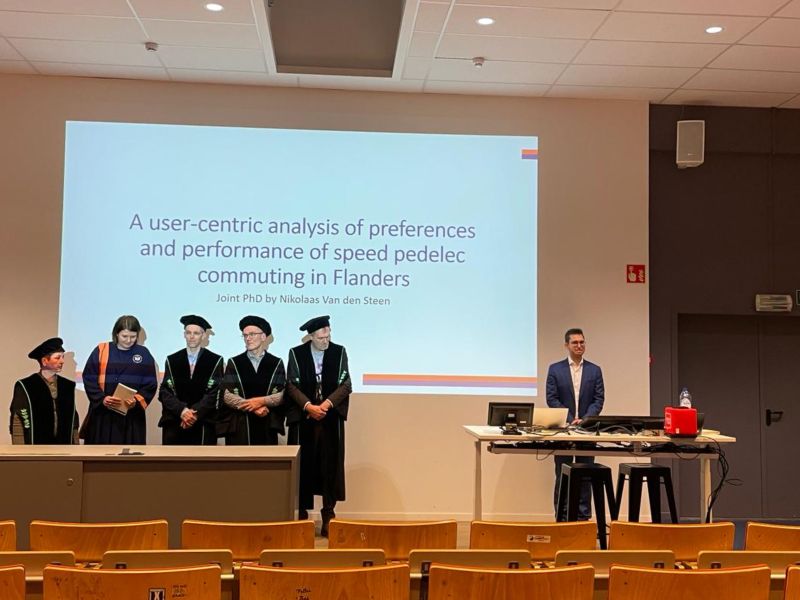
Unique Flemish PhD Unveils the Shortcomings and Promises of Speed Pedelecs
96 days ago
5 minutes
Nikolaas Van den Steen recently obtained the degree of Doctor of Engineering Technology with a PhD thesis on speed pedelecs. After years of research, he successfully defended his thesis entitled “A user-centric analysis of preferences and eperformance of speed pedelec commuting in Flanders”. His work stands out for its interdisciplinary approach, bridging natural and social sciences to unveil new and nuanced insights into the world of speed pedelecs.
Central to Van den Steen’s research was the 365SNEL project in which 105 riders were given the opportunity to commute with a speed pedelec for three weeks. He investigated both the performance of the speed pedelecs and the perception and preferences of the riders related to their speed pedelec commute.
Surprisingly, the study revealed a shift in riders’ motivations over time. Before the test, most riders were mainly motivated by the prospect of saving time by commuting with a speed pedelec. This ultimately turned out not to be true, but after the test, saving time was no longer an important motivation. Other benefits appeared to weigh more heavily. They especially appreciated that with a speed pedelec they always knew exactly how long their journey would take, as opposed to a car journey, which is always completely. Another important benefit was the fact that they experienced mental and physical benefits from daily cycling. Before the test rides, most riders mentioned the high cost of the speed pedelec and perceived traffic safety as the most important barriers. After the rides, those barriers still applied, but another important one emerged: lack of reliability of the speed pedelecs.
The dissertation provides an anthology of the defects: “There was only one test period out of the 10 conducted where there were no “defects” to one speed pedelec in the fleet. A summary of the defects encountered is: many flat tires, a bike stand broke off, battery connection problems, pedals broke off, charging problems, software malfunctions, chain breaks, broken gears, squeaking brakes, malfunctioning gear systems, broken mirror, broken gear shifter, a broken crank, motor malfunctions, battery casing came loose, oxidation of charging contacts, bolts came loose, ball bearing broke, spokes broke, saddle clamp broke, mudguard came loose, horn kept honking, horn did not work, bell broke, broken assistance controller, deformed tire, . . .” The research clearly showed that improving the operational reliability of speed pedelecs is one very important area for improvement for manufacturers.
The research has also clearly establishe that practical cruising speeds are below the 45 km/h maximum pedal assisted speed. The cruising speed depends on the vehicle, the users’ behaviour, their preferences and their capabilities. For example, women systematically achieved lower speeds than men, their cruising speed being overall 5 km/h slower than that of the men. This raises further questions not only about the usefulness, but even the safety of limiting assistance to a maximum of 4 times the cyclist’s own capacity. Not only most women, but all riders who are unable to provide sufficient force due to their physique or physical problems are punished for this on speed pedelecs where the maximum assistance is limited to factor 4.
Furthermore, these are very important findings for allocating a place for speed pedelecs on the road. It clearly shows that speed pedelecs have a completely different driving behaviour than classic mopeds and that it is therefore irresponsible to subject speed pedelecs to the same traffic rules as mopeds.
From the riders’ point of view, the research concludes that there is only one difference in preferences regarding dedicated cycle paths between conventional and electric cyclists, that is the need for charging points along the route. Apart from that, all cyclists want wide and high-quality cycle paths with safe crossing points, smart traffic lights and secure bicycle parking. Finally, the researcher found that, for an average Flemish commuter, a speed pedelec outperforms a car for commuting in four areas: time predictability, moderate to vigorous physical activity, total cost of ownership and CO2 emissions.
Nikolaan Van den Steen concludes: “These results first and foremost provide the first scientific data sets on such a scale for speed pedelecs. Secondly, the text proves that certain key preconceptions about the speed pedelec are wrong. Thirdly, the study shows the promise the vehicles hold to combat the challenges Belgium and the European Union faces, if they replace larger and heavier (internal combustion engine) vehicles. Finally, the work ends with policy advice and new avenues of future research in the field of speed pedelecs.”
The undersigned has had the honour and pleasure to work with Nikolaas in the 365SNEL project and to be part of the jury for his PhD thesis. The work that Nikolaas has done to conduct this research and complete his thesis is immeasurable. The result is invaluable: it is the first research into speed pedelecs that goes so deep and so wide. Hopefully new researchers from here will pick up the thread and explore the new avenues of future research in the field of speed pedelecs that Nikolaas has mapped out for them.
Annick Roetynck,
LEVA-EU Manager
The full dissertation is available here: https://rb.gy/3jj77l
Annick Roetynck
Annick is the Manager of LEVA-EU, with decades of experience in two-wheeled and light electric mobility.
Campaign success
Lorem ipsum dolor sit amet, consectetur adipisicing elit, sed do eiusmod tempor incididunt ut labore et dolore magna aliqua.
Member profile
Lorem ipsum dolor sit amet, consectetur adipisicing elit, sed do eiusmod tempor incididunt ut labore et dolore magna aliqua.